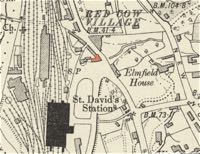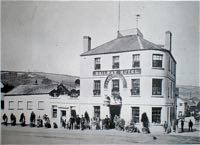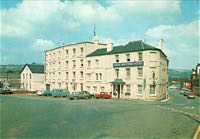
Great Western Hotel – St David's Station
Page updated 8th March 2016
It is not difficult to account for the name and position of this hotel, as it is right next to St David's Station on Brunel's Great Western Railway. The Great Western Railway arrived in Exeter in 1844. The line was opened by the Mayor, and the first passenger engine, The City of Exeter, was welcomed into the terminus by a large crowd. Seven trains departed for London Paddington that day. To take advantage of the many passengers passing through the station, and in competition with the nearby Red Cow Inn, an inn confusingly named Railway Station was opened in 1848 to the north of the station, and was promoted with an advert in the Flying Post:
‘RAILWAY STATION, EXETER JAMES HUTCHINGS avails himself of this opportunity, to return his thanks to his Friends and the Public, for the favours already bestowed on him, since he has opened the above Inn, and trusts by strict attention to the Comfort of Visitors to merit a continuation of their support. Visitors will find every accommodation, and attention combined with moderate charges. Genuine Wines, Spirits, &c. GOOD BEDS, STABLING AND LOCKUP COACH HOUSES The Inn being so near the Station, Travellers, by rail, will find it a great accommodation. Families supplied with Good House Brewed Beer.'
The railway network in Devon was still limited, and North Devon and the North Cornish coast had no rail service. In 1856, Hutchings Railway Hotel was an agent for coach tickets to and from Bude and Copplestone, which was timed to the mail train to and from Bristol and London. The coach service ran three times a week at a cost of 7s 6d. James Hutchings became a respected man and he was voted chairman of the Licensed Victuallers Protection Society in 1861, at the thirteenth annual meeting held at his hotel. He died in 1863, and the hotel was sold to James Underhill the next year. Underhill advertised the hotel as the Railway, Family and Commercial Hotel. The hotel offered stabling, lock-up coach houses and an attendant on every train. The hotel remained under James Underhill's management until his death at the age of sixty-four in July 1894.
The first time the hotel was referred to as the Great Western Hotel was in November 1894 when the Devon Rugby Football Union had a meeting there.
The failed grand scheme
In 1902 there were grand plans to rebuild the hotel and the Building News published an article and an architectural drawing of the planned construction.
"It is proposed to erect this building close to the main station of the Great Western Railway, St David's, at Exeter. The site is a commanding one, facing the chief approach to the station, and overlooking the delightful valley of the Exe. There are some acres of ornamental grounds in front, and a tramway leads from the station and hotel to the city. When erected it, will be a great boon to travellers to and from the West by the Great Western system, enabling them to stop near the station, and, after exploring the ‘Ever Faithful' city, to resume their journey in either direction by that Company's splendid service."
The renowned Cornish architect Sylvanus Travail won the contract to design the new building. As the drawing, on the right, indicates, it was going to be a Tudor style building, on a grand scale. The style and character of the building was intended to harmonise with the surroundings and traditions of the locality. The walling was to be of best pink brick with buff terra-cotta dressings and open-timbered work, as shown in the drawing. In the event the rebuild did not occur.
Mrs Pankhurst drops in
Mrs Emmeline Pankhurst visited the Great Western Hotel on one notable occasion in 1913. Due to her agitation for women's suffrage, she was subject to the so called Cat and Mouse Act (when the authorities would imprison her, and release her when she went on hunger strike, to then arrest her again when she had recovered). On 4 December, after she had visited the United States, she was arrested on the White Star liner, SS Majestic, when it anchored in Cawsands Bay, Plymouth on her return. She was brought by car over Dartmoor to be incarcerated at Exeter Prison. On 7 December, she was released on seven days licence, and proceeded to the Great Western Hotel, where a reporter from the Express and Echo spoke with her. She said she had spent a bad night and was only able to take invalid food. Mrs Pankhurst also spoke of the good treatment she received in the prison. She then left on the 10.15 a.m. train to Paddington, accompanied by friends.
Trust House
The Public Home Trust Company was the idea of the fourth Earl Gray in 1904. By the end of the nineteenth century, many country inns and hotels were struggling, due to the loss of passing trade after coaching services stopped. The result was that many inns pushed the consumption of alcohol, to increase turnover. Earl Gray intended that each county form a Public Trust with investment from prominent local families. The intention was to support local inns helping them to provide food and accommodation, and reduce drunkenness. The first Trust House was acquired in Hertfordshire. The first entry in an Exeter directory as a Trust House Hotel was in 1916, as the Great Western Hotel. The hotel had been recently purchased from Ching and Coppin, a wine merchant owned by Plymouth Breweries.
The hotel is in three distinct sections, with the earlier Railway Hotel on the corner of the Crediton Road (now Cowley Bridge Road). A small, three storey extension was probably added by James Underhill, according to the evidence of the OS maps. The large block to the left of the present hotel appears to be from two distinct phases. Research has not traced the date for these two sections, but they both probably date to the post Trust House era, in the 1920s to 1930s. There is a building at the rear, with a large chimney, which was the laundry.
The Trust Houses Group merged with Forte Holdings in 1970 to become Trust Houses Forte. Sometime later, the Great Western Hotel went into private ownership.
Directory entries
Some Flying Post and trade directory entries for the Railway Inn/Great Western Hotel:
1848 - Railway Station,
James Hutchings - Flying Post
1852
- Hutchings Railway Inn -
Flying Post advert for paint sale.
1859 - railway inn,
Crediton-road, Hutchings, J., - Trewman's. The address is
Crediton-road, which makes me think that this is the part of the
present hotel that faces Red Cow village. When they built the new
hotel, they probably incorporated the old railway inn, into the
structure.
1871 -
Underhill,
Jas., railway hotel, crediton-r -
Pocket Journal
1878 -
Railway,
James Underhill, St David's Hill,
Exeter - White's
1897 -
Railway, James Underhill, St Davids -
Kelly's
1923 - Railway
(Trust
House), St David's Hill. Post Office
1934
- Great Western Hotel, O'Kelly, H. K., Red Cow Village - Besley's
1956
- Great Western (Trust Houses) Ltd. (Geo. F. Burn, district manager),
Red Cow village - Kelly's
1967
- Great Western (Trust Houses)
Ltd. Station Approach, Red Cow village - Kelly's.
Sources: Trade directories, Building News, The British Newspaper Archive.
│ Top of Page │



